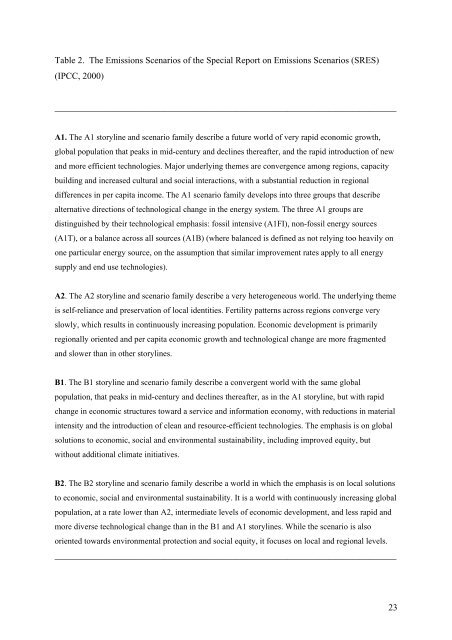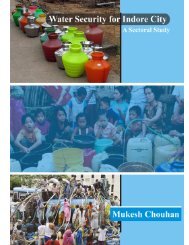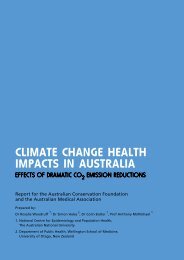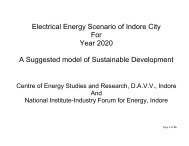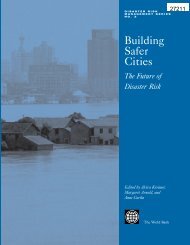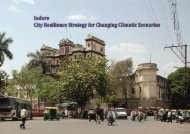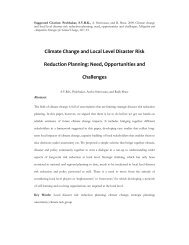Mapping climate vulnerability and poverty in Africa - CGSpace Home
Mapping climate vulnerability and poverty in Africa - CGSpace Home
Mapping climate vulnerability and poverty in Africa - CGSpace Home
You also want an ePaper? Increase the reach of your titles
YUMPU automatically turns print PDFs into web optimized ePapers that Google loves.
Table 2. The Emissions Scenarios of the Special Report on Emissions Scenarios (SRES)<br />
(IPCC, 2000)<br />
___________________________________________________________________________<br />
A1. The A1 storyl<strong>in</strong>e <strong>and</strong> scenario family describe a future world of very rapid economic growth,<br />
global population that peaks <strong>in</strong> mid-century <strong>and</strong> decl<strong>in</strong>es thereafter, <strong>and</strong> the rapid <strong>in</strong>troduction of new<br />
<strong>and</strong> more efficient technologies. Major underly<strong>in</strong>g themes are convergence among regions, capacity<br />
build<strong>in</strong>g <strong>and</strong> <strong>in</strong>creased cultural <strong>and</strong> social <strong>in</strong>teractions, with a substantial reduction <strong>in</strong> regional<br />
differences <strong>in</strong> per capita <strong>in</strong>come. The A1 scenario family develops <strong>in</strong>to three groups that describe<br />
alternative directions of technological change <strong>in</strong> the energy system. The three A1 groups are<br />
dist<strong>in</strong>guished by their technological emphasis: fossil <strong>in</strong>tensive (A1FI), non-fossil energy sources<br />
(A1T), or a balance across all sources (A1B) (where balanced is def<strong>in</strong>ed as not rely<strong>in</strong>g too heavily on<br />
one particular energy source, on the assumption that similar improvement rates apply to all energy<br />
supply <strong>and</strong> end use technologies).<br />
A2. The A2 storyl<strong>in</strong>e <strong>and</strong> scenario family describe a very heterogeneous world. The underly<strong>in</strong>g theme<br />
is self-reliance <strong>and</strong> preservation of local identities. Fertility patterns across regions converge very<br />
slowly, which results <strong>in</strong> cont<strong>in</strong>uously <strong>in</strong>creas<strong>in</strong>g population. Economic development is primarily<br />
regionally oriented <strong>and</strong> per capita economic growth <strong>and</strong> technological change are more fragmented<br />
<strong>and</strong> slower than <strong>in</strong> other storyl<strong>in</strong>es.<br />
B1. The B1 storyl<strong>in</strong>e <strong>and</strong> scenario family describe a convergent world with the same global<br />
population, that peaks <strong>in</strong> mid-century <strong>and</strong> decl<strong>in</strong>es thereafter, as <strong>in</strong> the A1 storyl<strong>in</strong>e, but with rapid<br />
change <strong>in</strong> economic structures toward a service <strong>and</strong> <strong>in</strong>formation economy, with reductions <strong>in</strong> material<br />
<strong>in</strong>tensity <strong>and</strong> the <strong>in</strong>troduction of clean <strong>and</strong> resource-efficient technologies. The emphasis is on global<br />
solutions to economic, social <strong>and</strong> environmental susta<strong>in</strong>ability, <strong>in</strong>clud<strong>in</strong>g improved equity, but<br />
without additional <strong>climate</strong> <strong>in</strong>itiatives.<br />
B2. The B2 storyl<strong>in</strong>e <strong>and</strong> scenario family describe a world <strong>in</strong> which the emphasis is on local solutions<br />
to economic, social <strong>and</strong> environmental susta<strong>in</strong>ability. It is a world with cont<strong>in</strong>uously <strong>in</strong>creas<strong>in</strong>g global<br />
population, at a rate lower than A2, <strong>in</strong>termediate levels of economic development, <strong>and</strong> less rapid <strong>and</strong><br />
more diverse technological change than <strong>in</strong> the B1 <strong>and</strong> A1 storyl<strong>in</strong>es. While the scenario is also<br />
oriented towards environmental protection <strong>and</strong> social equity, it focuses on local <strong>and</strong> regional levels.<br />
___________________________________________________________________________<br />
23


